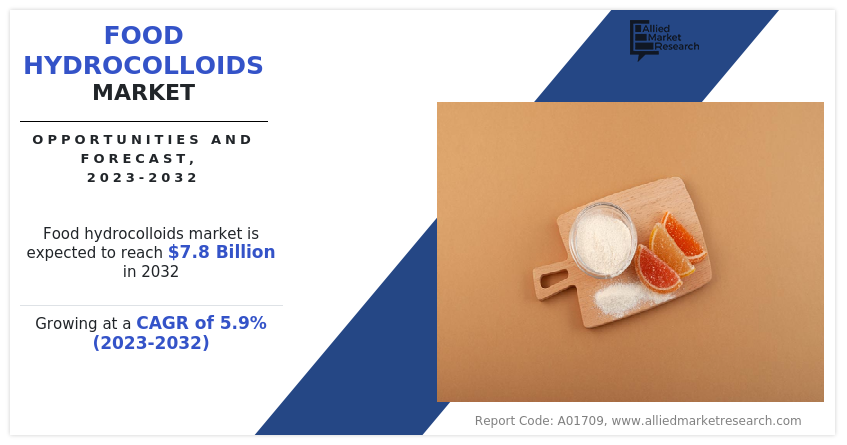Food Hydrocolloids Market Research, 2032
The global food hydrocolloids market was valued at $4.4 billion in 2022, and is projected to reach $7.8 billion by 2032, growing at a CAGR of 5.9% from 2023 to 2032. Food hydrocolloids are essential food additives derived from both plant and animal sources, extensively used within the food industry to enhance the texture, consistency, and stability of various food and beverages products. These versatile ingredients play a pivotal role in multiple food applications, including the creation of gels, thickening agents, emulsifiers, ensuring uniform distribution, whichthus prevent undesirable ice and sugar crystal formation, and facilitates precise control over flavor release in food products.
Market Dynamics
Food hydrocolloids are widely used in the production and manufacture of processed food products in the consumer market. Processed food offers exceptional convenience due to their instant consumption or minimal preparation requirements, which facilitates ease for individuals leading hectic lifestyle. The fast-paced lifestyle drives a preference for convenient meal choices, as it meets the demand for easy and quick food preparation without putting much efforts. Packaging strategies in food processing, such as canning, freezing, and vacuum sealing techniques, play a crucial role in extension of product shelf life, which thereby helps to reduce the frequency of necessary grocery shopping. In addition, as populations migrate to urban areas characterized by hectic routines, access to fresh ingredients and traditional cooking methods becomes limited, which drives the demand for processed food. As a result of surge in dependence on processed foods, the market has experienced increased utilization of food hydrocolloids in processed food and beverages. Moreover, advancements in food hydrocolloids have yielded products with enhanced taste profiles and improved health benefits, along with potential nutritional requirements such as adequate amount of dietary fibers in food products. The food hydrocolloids help in addition of dietary fibers in food items, as a result of which there is increased usage and application of food hydrocolloids in variety of packaged food and beverages products. This has high potential to drive the growth of food hydrocolloids industry during the forecast period.
The instability in the prices of raw materials creates a barrier for food hydrocolloid manufacturers to maintain a consistent product pricing on the global market. This unpredictability adds complexity to establish long-term contracts for both consumers and firms that heavily rely on specific raw material suppliers for the supply of food hydrocolloids. The rapid fluctuations in these costs can potentially hamper the growth of novel hydrocolloid-based product development, which may act as a restraint to the expansion of the food hydrocolloids market. The volatilities in raw material costs hold the potential to add up to the rising prices for final products that uses hydrocolloid as one of the raw materials to produce it. As a result, there may be an impact on purchasing behavior of consumers, particularly in markets that comprises of customers sensitive to sudden price changes. The variability in raw material prices has the potential to affect supply chain planning and inventory management processes, owing to imbalance in supply and demand in the market.
Furthermore, hydrocolloids have found traction in the burgeoning sector of 3D food printing, which facilitates personalized food crafting and medium scale production. The success of 3D food printing depends on a strong control of food matrix properties that includes consistency, viscosity, and solidification properties. There are research works which suggests that enhancing the suitability of soy protein isolate for 3D printing may be achieved through the integration of sodium alginate and variable concentrations of gelatin. Thus, it may present huge opportunities for food hydrocolloids market share owing to it properties, which may lead to steady increase in the market growth of the market in the forecasted period.
Segmental Overview
The food hydrocolloids market is segmented into type, source, application, and region. Based on type, the market is divided into gum Arabic, carboxymethyl cellulose, xanthan gum, carrageenan, pectin, and others. On the basis of source, it is segregated into plant, animal, and microbial. By application, it is fragmented into bakery, confectionery, sauces, dressings, marinades and gravies, beverages, dairy and frozen desserts, & convenience and processed foods. Region wise, the market is analyzed across North America, Europe, Asia-Pacific, and LAMEA.
By Type
The xanthan gum segment, as per type, dominated the global food hydrocolloids market in 2022 and is anticipated to maintain its dominance throughout the forecast period. Xanthan gum exhibits versatility that drives its increased adoption in various food applications. It serves as an important additive in baked goods such as bread and cakes, as it enhances water retention and softness during baking and storage process. It improves taste, extends the shelf life of food products, and enhances water retention while tenderizing and improving water retention in meat products, thus this quality propels the use of food hydrocolloids in the meat packaging industry. In addition, it possesses properties such as thickening and stabilizing in frozen food, which helps to maintain sturdiness of food items. Xanthan gum also enhances the taste, water retention, and overall quality of jams and jellies, which drives the demand for xanthan gum in this segment. In beverages, it acts as a thickener and suspension agent that imparts a smooth texture and natural flavor of different type of drinks. It contributes to the stability of ice cream and dairy products when used alongside with guar gum and locust bean gum, driving the application of hydrocolloids in the dairy sector. Furthermore, the ability of xanthan gum to lower blood sugar levels in substantial quantities contributes to its favor as an ingredient in various beverages. This popularity is driven by the worldwide rise in consumption of beverages and packaged goods across the globe.
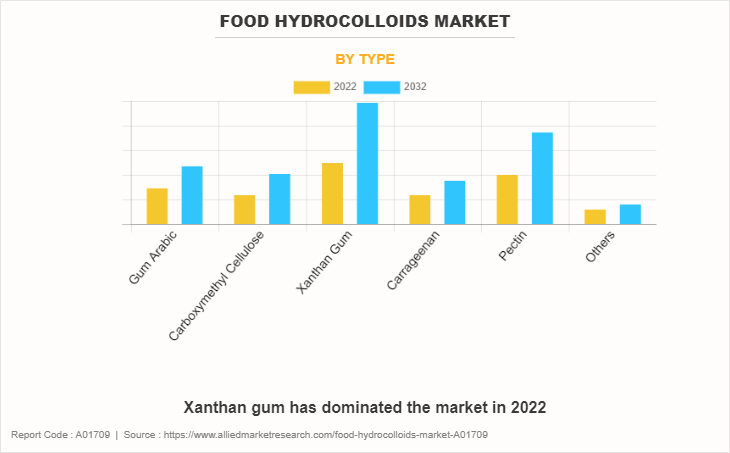
By Source
As per source, the plant segment dominated the global food hydrocolloids market in 2022 and is anticipated to maintain its dominance throughout the forecast period. The preferences of health-conscious consumers have driven the growth of plant-based hydrocolloids in the market. These foo hydrocolloids, derived from plants, offer functional benefits without any addition of synthetic additives. They act as substitutes for animal-based options, which meets texture and functionality requirements, particularly catering to those following vegan or vegetarian diets. This trend has the ability to align with the clean label movement, which emphasizes the demand of consumers for transparent and recognizable ingredients in their food and beverages. Moreover, concerns about allergens and a growing focus on environmental sustainability have significantly pushed the adoption of sustainable and plant-based choices. This shift has further helped to boost the demand for plant-based hydrocolloids in recent years. In addition, technological advancements in extraction of hydrocolloids from plants enables these hydrocolloids to comply with regulations, expand across industries, and align with marketing strategies that emphasize natural, eco-conscious, and health-focused attributes.
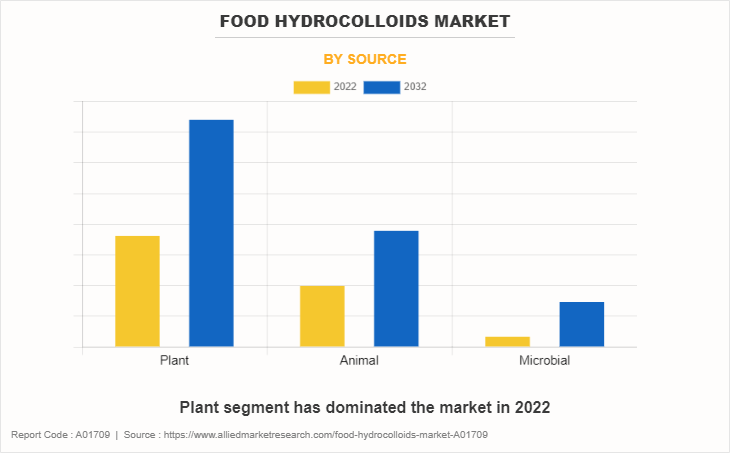
By Application
As per application, the dairy and frozen desserts segment dominated the global food hydrocolloids market in 2022 and is anticipated to maintain its dominance throughout the forecast period. The strong demand for dairy beverages rises from preference of consumers for dairy products owing to their high nutritional value. The expansion of various retail outlets, particularly in developing markets, has improved the accessibility of dairy products, thereby contributing to the growth of the food hydrocolloids market within the dairy industry. There is a rise in popularity of frozen food in developing countries owing to the shift in consumer lifestyle and preferences, which has led to an increased application for food hydrocolloids in frozen food segments. The rise in per capita income across the Asia-Pacific countries has led to change in dietary preferences and lifestyle of consumers, thus increasing the consumption of dairy and frozen food in the region. This aspect has driven the usage of food hydrocolloids to maintain the stability of food item and extend its shelf life. In addition, Latin America and Middle Eastern countries have witnessed significant economic development that has increased the purchasing power of consumers and has led to surge in demand for processed food items which uses hydrocolloids as ingredient. Thus, it has led to significant growth in terms of food hydrocolloids market size.
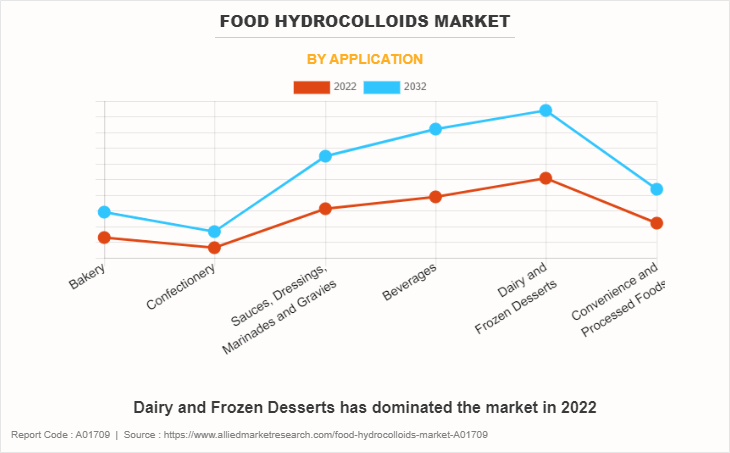
By Region
Region-wise, Europe is predicted to dominate the market with the largest share during the forecast period (2023-2032). The surge in demand for processed food across Europe has propelled the utilization of food hydrocolloids due to their ability to enhance texture, flavor, and prolong shelf life of these products. The increasing interest in functional food also contributes to the expansion of the food hydrocolloids market in Europe. The rise in demand for health-conscious beverage alternatives, such as fruit-infused beverages and energy drinks, has seen significant growth among consumers as a response to the adverse health impacts linked to carbonated beverages. This consumer inclination is predicted to persist and influence the market landscape in the forecasted period. Moreover, factors such as the increase in demand for distinctive flavors and changing consumer preferences act as drivers for the growth of the food hydrocolloids market demand in Europe.
The food hydrocolloids market within the Asia-Pacific region is expected to have fastest growth in the upcoming years. The influence of westernization across the region has prompted a shift in taste preferences toward processed food and packed beverages. This shift has led to an increased inclination towards convenient and readily consumable meals, which supports the demands of consumers with busy lifestyle. Moreover, the upsurge in consumption of dairy, bakery, and beverage products in the region presents significant potential for the expansion of the food hydrocolloids market. The relatively lenient government regulations in this region have also facilitated the emergence of numerous businesses in the food hydrocolloids market, which may foster competition and encourage innovation in wide application of new hydrocolloids in the food industry. Furthermore, factors such as increased purchasing power, rapid transitions in dietary habits, urbanization, the absence of robust regulatory frameworks, a wide and diverse customer base, and a preference for instant processed food products collectively drive the growth of this market within the region during the food hydrocolloids market forecast.
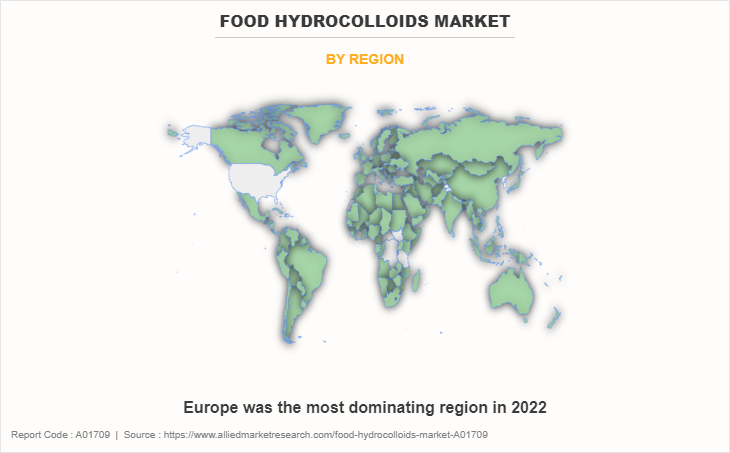
Competitive Landscape
The major players analyzed for the food hydrocolloids market are CP Kelco U.S., Inc., Cargill, Incorporated, Ingredion Incorporated, Tate & Lyle PLC, Kerry Group plc, Jungbunzlauer Suisse AG, Deosen Biochemical (Ordos) Ltd., Ashland, Koninklijke DSM N.V., and International Flavors & Fragrances Inc.
Players in the food hydrocolloids market are actively engaged in meeting dynamically changing customer demands by continuous production of new and innovative hydrocolloids with enhanced features, which has driven the food hydrocolloids market growth in recent years. These market players invest in research and development to drive innovation in technology, improve functionality, and provide greater choice to their customers. As a result of which they collaborate with different suppliers, regulatory bodies, and industry stakeholders to implement application of food hydrocolloids, along with regulatory compliance, and stay ahead of industry trends. Manufacturers are focused on expansion of utilization of food hydrocolloids while optimizing costs, which may help them to cater to the increase in demand from the customer.
Key Benefits for Stakeholders
- This report provides a quantitative analysis of the market segments, current trends, estimations, and dynamics of the food hydrocolloids market analysis from 2022 to 2032 to identify the prevailing food hydrocolloids market opportunities.
- The market research is offered along with information related to key drivers, restraints, and opportunities.
- Porter's five forces analysis highlights the potency of buyers and suppliers to enable stakeholders make profit-oriented business decisions and strengthen their supplier-buyer network.
- In-depth analysis of the food hydrocolloids market segmentation assists to determine the prevailing market opportunities.
- Major countries in each region are mapped according to their revenue contribution to the global market.
- Market player positioning facilitates benchmarking and provides a clear understanding of the present position of the market players.
- The report includes the analysis of the regional as well as global food hydrocolloids market trends, key players, market segments, application areas, and market growth strategies.
Food Hydrocolloids Market Report Highlights
| Aspects | Details |
| Market Size By 2032 | USD 7.8 billion |
| Growth Rate | CAGR of 5.9% |
| Forecast period | 2022 - 2032 |
| Report Pages | 275 |
| By Type |
|
| By Source |
|
| By Application |
|
| By Region |
|
| Key Market Players | Tate & Lyle PLC, Koninklijke DSM N.V., Cargill, Incorporated, Jungbunzlauer Suisse AG, Ashland Inc., CP Kelco, Ingredion Incorporated, Kerry Group plc, Deosen Biochemical (Ordos) Ltd., International Flavors & Fragrances Inc. |
Analyst Review
According to the perspective of the top-level CXOs, the food hydrocolloids market is growing at a significant pace, and is anticipated to continue this trend in the coming years. Top executives in the food industry exhibit optimism opinion about the growth potential of the food hydrocolloid market. They identify several factors that drive this growth, including the rising demand for convenience foods. The increasing popularity of healthy and functional foods, coupled with the broad application of hydrocolloids to infuse dietary fiber, protein, and other nutrients into foods, fuels the demand for food hydrocolloids across various culinary applications.
The growing preference for vegetarian and vegan food has heightened the utilization of food hydrocolloids. These are applicable in preparation of meatless and dairy-free alternatives that replicate the texture and taste of animal-based products. A major driver of the food hydrocolloid market expansion is the surge in popularity of processed foods. These hydrocolloids find common use in processed food to enhance texture, maintain moisture, and extend shelf life.
Moreover, the growth of the food hydrocolloid market receives support from the development of fresh and innovative hydrocolloids with improved properties. Furthermore, the increasing regulatory approval of hydrocolloids in food applications presents ample growth opportunities for the market on a global scale.
The global food hydrocolloids market was valued at $4.4 billion in 2022, and is projected to reach $7.8 billion by 2032
The global Food Hydrocolloids market is projected to grow at a compound annual growth rate of
The major players analyzed for the food hydrocolloids market are CP Kelco U.S., Inc., Cargill, Incorporated, Ingredion Incorporated, Tate & Lyle PLC, Kerry Group plc, Jungbunzlauer Suisse AG, Deosen Biochemical (Ordos) Ltd., Ashland, Koninklijke DSM N.V., and International Flavors & Fragrances Inc.
Region-wise, Europe is predicted to dominate the market with the largest share during the forecast period (2023-2032).
Increase in demand for processed foods, Rise in awareness related to health benefits of hydrocolloids, Rise in popularity of gluten-free and allergen-free alternatives
Loading Table Of Content...
Loading Research Methodology...

